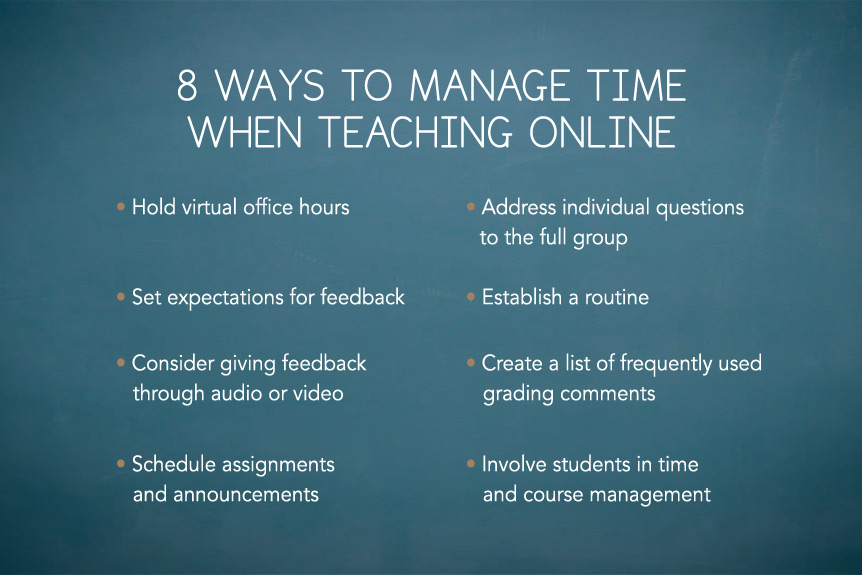
There is a rhythm to teaching in higher education. We work within semesters, quarters, or terms that last a set number of weeks. Within a given term, we teach in chunks of time, with classes lasting 50 minutes, 3 hrs, 8 hrs, or other increments, often designated by the number of credit hours they are worth. Teaching online requires reconsidering traditional notions of time. When we teach online, no longer does teaching have to occur synchronously at a fixed time and location during a pre-set class session. Rather, teaching and learning can, and often do, occur asynchronously, with individual students completing the class at different times and at different rates. In some sense, the online teaching environment exists outside of the traditional time framework.
Some scholars have asserted that the amount of time faculty spend teaching online is greater than that spent teaching onsite. In an American Council of Education Report, Levine and Sun, for example, suggest that:
Distance learning entails a host of teaching and learning practices that may be convenient for students but are far more labor-intensive than traditional college practices: Creating courses, maintaining chat rooms, and responding to e-mails from students around the clock requires far more time and energy from faculty than traditional courses. Additionally, distance learning comes with a new language and different expectations, including anytime, anyplace learning, 24/7 advising, and round-the-clock availability of instructors.

Faculty seem to agree that teaching online takes more time than teaching onsite. Several surveys of and interviews with faculty suggest that most faculty who have taught online indicate that it takes more time than teaching onsite. So with all the demands on today’s college teachers, it is little wonder that the time it takes to teach in this environment can be a barrier to faculty involvement.
There is good reason that faculty believe that teaching online takes more time. When we teach onsite, our teaching activities tend to occur in blocks of time. We may have blocks of time set aside for course preparation, blocks of time for teaching, and blocks of time for office hours or responding to emails. These times seem linear, and they are bounded and contained. When we teach online, time is more fragmented. For asynchronous course components, we do not teach at a set time; instead, we teach in the moment, responding to emails, commenting on discussions, grading. Since there is no block of time for meetings, we teach in smaller and more frequent chunks of time. This leads to a sense of broken time, which can then leave fewer blocks of concentrated time for other professional or personal activities.

For this reason, time management is essential. There are several important ways in which we can seek to manage time when teaching online.
1. Hold Virtual Office Hours
Hosting regular virtual office hours can decrease the number of emails you receive. If students do not attend, and they may not, or if there are gaps between meetings, you can use this scheduled time to respond to emails and grade assignments or discussion posts.
2. Address Individual Questions to the Full Group
If one student has a question, it is very likely that other students have the same question. You can set up a thread for students to post general questions, and you can answer it once instead of multiple times. Moreover, other students may be able to answer them on their own. You can also include a FAQ as part of the course structure, which you can update regularly.
3. Set Expectations for Feedback
It is a good idea to respond regularly, but this does not mean responding immediately to every query. Simply tell students when they should expect a response when they send emails or submit assignments. For example, you could tell them to expect a response within 24 hours. Or that they should expect a grade within a week.
4. Establish a Routine
Set aside the same time every day to respond to emails, facilitate discussions, and grade assignments.
5. Consider Giving Feedback Through Audio or Video
Some instructors find it more efficient to record their comments directly into their students’ assignments than writing them all out. You can also respond with short informal videos, for example to the discussion posts for the week.
6. Create a List of Frequently Used Grading Comments
Many of us repeat the same phrase frequently when grading. Save these to a list and cut and paste as appropriate.
7. Schedule Assignments and Announcements
Instead of writing new announcements each week, write them at once and schedule their release. This can include information about what is due each week. You can of course add to the announcements, but having some set up ahead of time can be more efficient and less stressful than writing them right before they are due.
8. Involve Students in Time and Course Management
Students can assume ownership roles that will help not only with the course management but also with their learning. For example, they can help set the ground rules for discussions, they can take turns summarizing the weekly discussion board, and they can give each other feedback on their learning. For two examples of the latter, try the following techniques:
- In Dyadic Essays students: 1) complete a content unit, identify a central question, and draft an answer to that question, 2) exchange questions with a peer and prepare responses, and 3) read and compare the model and in-class answers with their partner.
View main video here: View Technique →
View online adaptation here:
- In Invent the Quiz, students write a limited number of test questions related to a recent learning module and then create an answer sheet, or alternatively a model answer and scoring sheet, to accompany the test questions.
View main video here: View Technique →
View online adaptation here:
The answer to the question of whether teaching online takes more time than teaching onsite is a resounding “maybe.” While evidence in time log and qualitative studies is mounting that teaching online takes more time than teaching onsite, further research is needed to provide a definitive answer. Such findings need to be considered in the light of the potential for increased efficiency over time, and thus longitudinal studies have the potential to improve our understanding of this important issue. At the very least, however, faculty perceive that teaching online takes more time, likely due to the shift in the ways in which faculty members experience time when teaching with online technology. For these reasons, faculty who teach online need to be particularly aware of time issues and to manage the challenges inherent in them.
Sign Up for Our Newsletter
Enter your email below to receive information about new blog posts.
Reference:
Major, C. H. (2015). Teaching online and instructional change: A guide to theory, research, and practice. Baltimore, MD: Johns Hopkins University Press.
Suggested Citation
Barkley, E. F., & Major, C. H. (n.d.). 8 time management tips for online teaching. CrossCurrents. https://kpcrossacademy.org/time-management-in-online-courses/

Engaged Teaching
A Handbook for College Faculty
Available now, Engaged Teaching: A Handbook for College Faculty provides college faculty with a dynamic model of what it means to be an engaged teacher and offers practical strategies and techniques for putting the model into practice.





